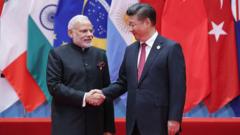In response to a burgeoning class of young achievers, India’s luxury club landscape is evolving, pushing aside colonial-era traditions in favor of modern, inclusive environments that cater to creative entrepreneurs and self-made millionaires.
India's Wealthy Embrace New-Style Membership Clubs for Modern Networking

India's Wealthy Embrace New-Style Membership Clubs for Modern Networking
As India's elite shift away from traditional colonial clubs, innovative membership spaces like Soho House are redefining social dynamics for the new affluent class.
In the heart of India's economic surge, a seismic shift in the landscape of exclusive social spaces is underway. Traditionally dominated by colonial-era clubs and gymkhanas, which have long served the country's elite, a new breed of members-only establishments is emerging, targeting a younger, more diverse demographic of wealth creators. These modern settings reflect the dramatic changes in India's societal fabric and are providing a refreshing alternative for the new affluent class.
For decades, establishments steeped in Raj-era decorum, filled with mahogany furnishings and strict dress codes, have catered to a select few – often the old guard of business tycoons, bureaucrats, and aristocrats. However, this exclusive scene now struggles to resonate with India's rising young entrepreneurs who find these venues outdated and unwelcoming. The contemporary demand has sparked the rapid growth of clubs like Soho House, which aims to facilitate networking in a more informal environment.
Soho House, originating in London, brought a fresh perspective to private membership clubs by catering to creators, thinkers, and entrepreneurs who often felt out of place in traditional settings. Following the successful launch of its oceanfront Mumbai location, the brand is now expanding further into major cities, anticipating a significant surge in demand from India’s burgeoning class of high-net-worth individuals. Kelly Wardingham, Soho House's Asia regional director, explains that this new demographic values community and collaboration, contrasting starkly with the old methods of exclusivity based on lineage or wealth.
Reema Maya, an aspiring filmmaker, highlights the benefits of her membership at Soho House. She states that it connects her to influential individuals across Mumbai's entertainment industry, a network often unattainable without the right social standing. This mirrors a historical hesitancy; many from the creative sector, like Bollywood actor Feroz Khan, once struggled to gain entry into such clubs.
Market analysts note the growing popularity of these modern clubs can be partly attributed to the limited availability of traditional gymkhanas, presenting a mismatch between demand and supply. Meanwhile, a unique array of new entrants now includes not just Soho House but other upscale private clubs backed by global brands such as St Regis and Four Seasons. This burgeoning market, aiming at affluent aspirants, has witnessed consistent growth, fueled by a culture shift that gained momentum post-pandemic.
However, while these clubs celebrate a more democratic ethos promoting artistic and entrepreneurial values, they still maintain considerable exclusivity. Many clubs enforce invite-only policies and charge high membership fees that remain beyond the reach of a vast majority of the Indian population. For instance, at Soho House, annual membership fees exceed what many earn in a month, underscoring a persistent divide despite the emergence of a new self-made elite in India.
This trend toward luxury membership clubs mirrors broader economic shifts in the country post-liberalization, leading to vast wealth accumulation among the upper echelons while the general populace lags significantly behind. As India's affluent class continues to swell, opportunities grow for luxury service providers looking to cater to an emerging market of prosperous young professionals eager for exclusive spaces to connect and innovate.
In this rapidly evolving landscape, India’s elite are not merely reimagining their social spaces; they are also reshaping the boundaries of entrance and influence, paving the way for a new generation of wealth and collaboration amid the complexities of a diverse society.




















